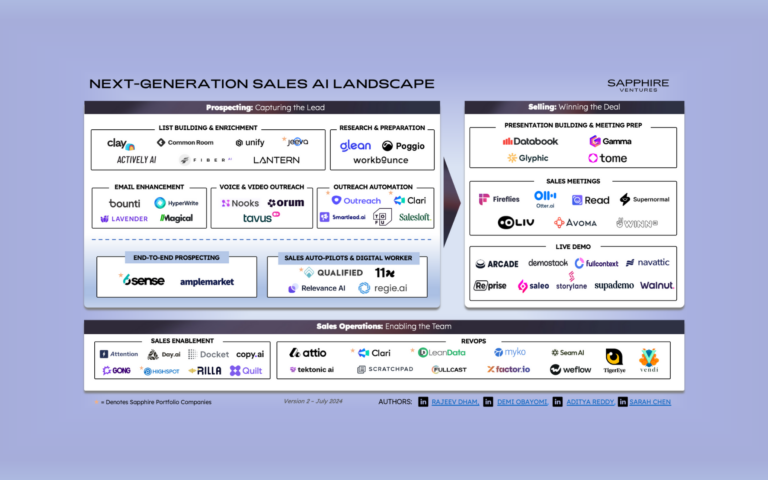I believe that one of the most impactful programs a Revenue organization can run is the revenue planning cycle. It often serves as the guardrails for a successful year and projecting growth, and if done well, can help drive highly coordinated execution.
As your company scales in size and complexity, this initiative often becomes even more critical, but arguably far more complex. If you don’t have a great grasp on the sequencing, best practices, and ‘gotchas’ of a planning cycle, there’s a chance you’ll stumble along the way and miss out on the chance to align your organization.
To help Revenue and Operations leaders wrangle this complex program, I’m sharing my perspective on the tenets of planning, and the top dos and don’ts to consider when getting started with revenue planning.
5 Key Elements of a Revenue Plan
Before I share some of the dos and don’ts, I want to level set on the tenets of what I believe to be a great planning process. A successful planning cycle consists of five key work streams that lead to very specific deliverables:
- Go to Market (GTM) Strategy: In my opinion, focus is your best friend in revenue planning. The first order of business in any planning cycle is to define the target market you want to capture for the year given your product roadmap and corporate objectives. This documented GTM strategy informs and aligns all your planning decisions.
- Target and Quota Setting: As you define your GTM strategy, it’s often critical to quantify it with Revenue targets. These targets are typically reflective of your long range financial models to start, but are then pressure tested by your planning team. This is done by breaking down your revenue targets into their underlying assumptions (ASPs, funnel conversion, cross sell and upsell expansion rates, etc). I’ll go into this process in-depth soon.
- Org Design & Resource Planning: This is where the rubber usually hits the road given my experience. Once you know your GTM focus and the assumptions behind your revenue targets, then it’s up to your revenue planning team to work with revenue leadership to re-design (or tune) your org to support your revenue plan’s execution. This may include adding resources to existing roles, creating new roles, and re-architecting the org structure to support your new GTM model.
- Incentive Strategy & Design: In my experience, your comp plan is your most effective tool to align seller behavior with business goals. Taking the time to define the right measures per role, the base/variable mix, rate tables/acceleration curves can benefit you tremendously.
- Territories & ROEs: I believe that it’s imperative to develop equitable territories supported by clear rules of engagement (ROEs) that outline ownership guidelines, split policies, hand-off lengths etc. Done well, this will support a balanced attainment curve for salespeople and reduce attrition risks.
Top Revenue Planning Best Practices
Putting the key revenue planning elements in place is only the first step in your revenue planning journey. Based on my past revenue leadership experiences, I’ve identified a few best practices to keep in mind when running an exceptional planning cycle:
- Revenue planning is a piece of the puzzle. The most effective organizations often use the planning process to align your entire organization; a company planning process is at the heart of this. This includes developing corporate objectives (OKRs), resource/capacity planning across all functions, understanding product roadmaps and incorporating into your growth assumptions, and ultimately threading all of this into your revenue planning process. Doing revenue planning in a silo (with only the revenue team) can be a missed opportunity.
- Set expectations. Align stakeholders with a clear deliverables calendar and guiding principles at the start of your planning process. I typically do this during a ‘kickoff meeting’ with strategic and tactical teams to make sure everyone has clarity on how we will make decisions, what we will expect from team members and what they can expect from us. The more proactive you are in bringing your stakeholders along, the easier it will be to make decisions with them.
- Define your ICP and target personas. I feel this should happen prior to your planning cycle (typically in the first half of the year). Find time with your product, revenue and corporate strategy teams to understand what markets, products, and segments you will be unlocking in the year ahead and which ones you may be doubling down on. This will inform your planning assumptions and data acquisition efforts.
- Prioritize data acquisition and quality. The ability for you to drive successful execution is commonly predicated on having the data to enable your teams. It can act as the foundation for successful territories, cleaner rules of engagement (ROEs), and team selling. I’d suggest focusing attention early on how you are acquiring, cleansing and connecting (via hierarchies) accounts and personas in your target market.
- Invest in scenario planning and modeling. While it isn’t the be-all & end-all, scenario planning and modeling are also instrumental in offering guardrails for a planning cycle. I like to use ‘seller productivity’ models to understand hiring needs, funnel math to understand top-line territory potential, and product-level (retention + cross sell + upsell) models to determine gross and net retention. At the highest level, it’s important to have a set of baseline assumptions on why your business will improve Y/Y. Whether its ASPs, conversions, headcount, funnel throughput, or something else, it’s important to define early and manage the plan to these assumptions.
- Integrate capacity and budget planning. To define your necessary FP&A budget, it’s often essential that you take the time early on to understand the work your org needs to do to support running the business activities, departmental plans, and corporate objectives. Based on this, you can clearly isolate what your resourcing requirements are and ultimately have a data-driven conversation with your finance counterparts on resourcing.
- View incentive strategy and execution as a three-legged stool. In my opinion, this is one of the most meaningful ways to drive behavior but is often minimized or owned by a single group. In my experience, the most effective organizations have a triumvirate of people leaders, finance leaders and revenue leaders coming together to define the incentive strategy and execution.
- Aim to have a progressive release of your plan through the cycle. In my opinion, there are certain elements of the plan that you should socialize early so your execution teams can prepare. I like to share funnel math assumptions (ASP, win rates, expansion rates, productivity, etc) early so teams can understand what’s expected of them. Socializing territories for install teams (they typically need to engage 3 months early for renewals), rules of engagement, and hiring plans early are all ways to drive zero-day readiness.
- Include execution plans in the planning cycle. Too many times I’ve been caught in the pitfall of creating a perfect ‘paper plan’ without asking my execution teams to articulate how they will achieve these objectives. I would suggest making space late in the revenue planning cycle for your revenue teams to craft an execution plan that supports the targets, resourcing and plan assumptions you have shared. This ensures that you are able to co-create success and drive everyone from the theoretical to the practical.
Ultimately, I believe well crafted revenue planning is the best way to solve for efficiency metrics while maintaining or accelerating your revenue growth. While most companies have different approaches to planning, the nine best practices I listed above should translate to almost any organization. As you prepare for your upcoming planning cycle, see if you can integrate some of these into your workflow.



